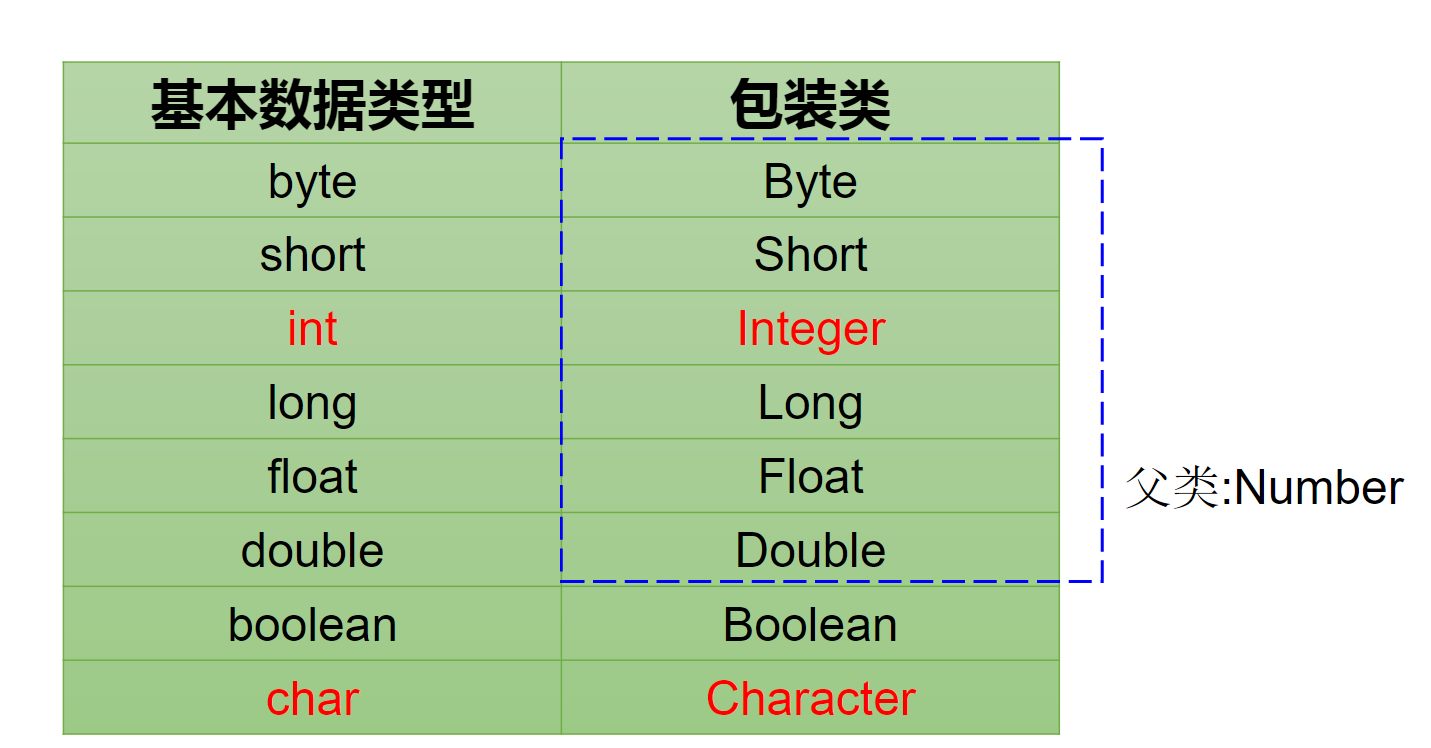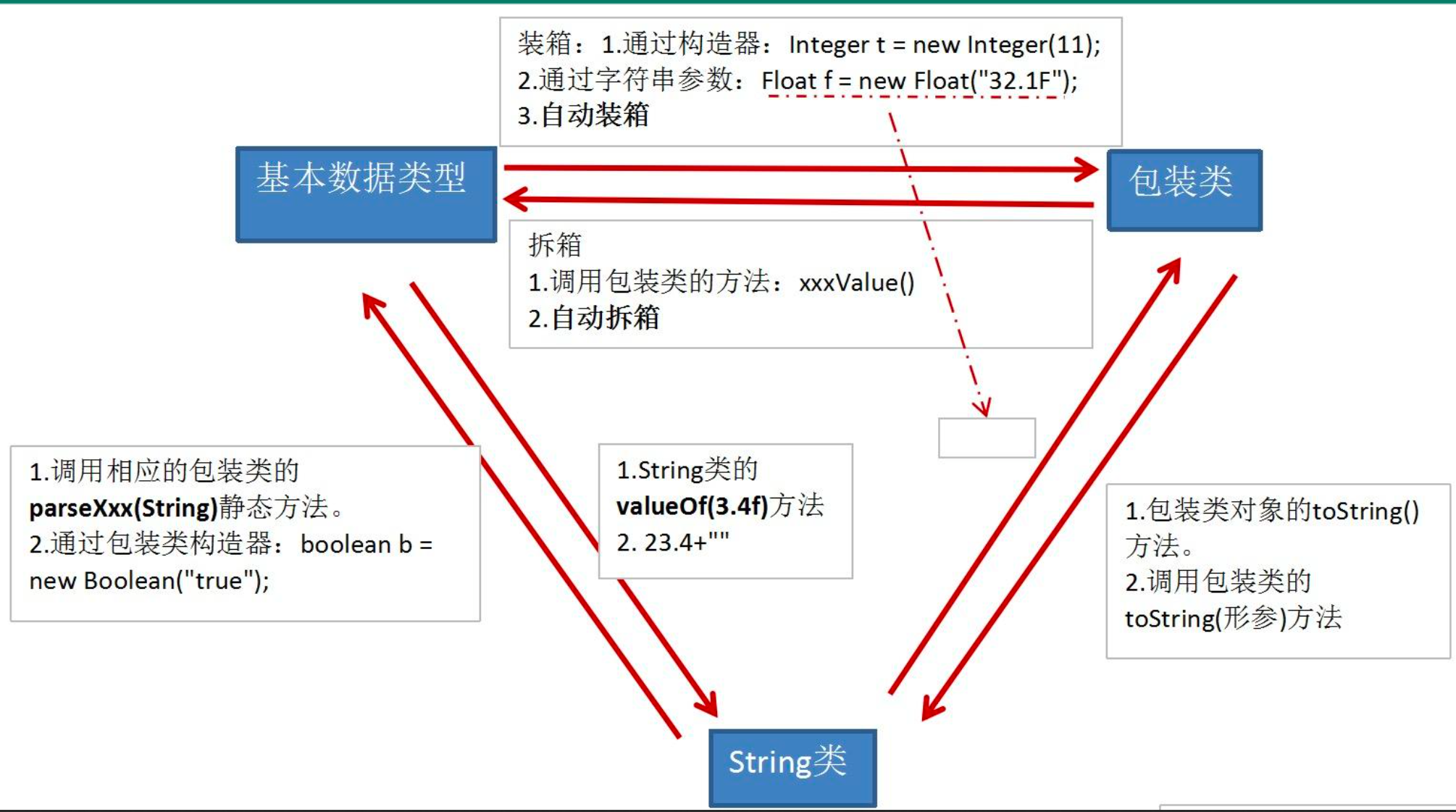 包装类
包装类
# 包装类wrapper
- 针对八种基本数据类型定义相应的引用类型—包装类(封装类)
- 有了类的特点,就可以调用类中的方法,Java才是真正的面向对象

有了包装类以后,才能使用多态,能以多态的方式作为参数传输。
# 基本数据类型转换为包装类
装箱:包装类使得一个基本数据类型的数据变成了类。
基本数据类型包装成包装类的实例---装箱
通过包装类的构造器实现:
int i = 500;
Integer t = new Integer(i);
1
2
2
还可以通过字符串参数构造包装类对象:
Float f = new Float(“4.56”);
Long l = new Long(“asdf”); //NumberFormatException
1
2
2
有了类的特点,可以调用类中的方法:
String s = f.toString();
1
# 包装类转换为基本数据类型
拆箱:将数字包装类中内容变为基本数据类型。
获得包装类对象中包装的基本类型变量---拆箱
调用包装类的.xxxValue()方法:
boolean b = bObj.booleanValue();
1
int j = t.intValue();
1
包装类不适合运算,需要转换为基本数据类型才适合运算。
# 自动装箱与自动拆箱
JDK1.5之后,支持自动装箱,自动拆箱。但类型必须匹配。
Integer i = 100;//自动装箱
Boolean b = false;//自动装箱
int num = i;//自动拆箱
1
2
3
2
3
注意Boolean默认为null,不是false。
# 基本数据类型包装类与String的相互转换
字符串转换成基本数据类型
通过包装类的构造器实现:
int i = new Integer("12");
1
包装类在实际开发中用的最多的在于字符串变为基本数据类型。
通过包装类的parseXxx(String s)静态方法:
Float f = Float.parseFloat("12.1");
1
基本数据类型转换成字符串
调用字符串重载的valueOf()方法:
String fstr= String.valueOf(2.34f);
1
更直接的方式:
String intStr = 5 + "";
1
连接字符串。
# 包装类常见面试题
面试题1
Object o1 = true ? new Integer(1) : new Double(2.0);
System.out.println(o1);
1
2
2
结果是1.0。
为什么结果不是1,编译的时候,三元运算符要求数据类型一致,整数类型自动提升为浮点型了。
面试题2
Object o2;
if (true) {
o2 = new Integer(1);
}else{
o2 = new Double(2.0);
}
System.out.println(o2);
1
2
3
4
5
6
7
2
3
4
5
6
7
结果是1。
这里没要求数据类型是一致,所以不会发生数据类型的自动提升
面试题3
Integer i = new Integer(1);
Integer j = new Integer(1);
System.out.println(i == j);//false
Integer m = 1;
Integer n = 1;
System.out.println(m == n);//true
Integer x = 128;
Integer y = 128;
System.out.println(x == y);//false
1
2
3
4
5
6
7
8
9
10
11
2
3
4
5
6
7
8
9
10
11
第一个是false,因为比较的引用地址。
第二个是true,第三个是false
来看看Integer源码:
private static class IntegerCache {
static final int low = -128;
static final int high;
static final Integer cache[];
static {
// high value may be configured by property
int h = 127;
String integerCacheHighPropValue =
sun.misc.VM.getSavedProperty("java.lang.Integer.IntegerCache.high");
if (integerCacheHighPropValue != null) {
try {
int i = parseInt(integerCacheHighPropValue);
i = Math.max(i, 127);
// Maximum array size is Integer.MAX_VALUE
h = Math.min(i, Integer.MAX_VALUE - (-low) -1);
} catch( NumberFormatException nfe) {
// If the property cannot be parsed into an int, ignore it.
}
}
high = h;
cache = new Integer[(high - low) + 1];
int j = low;
for(int k = 0; k < cache.length; k++)
cache[k] = new Integer(j++);
// range [-128, 127] must be interned (JLS7 5.1.7)
assert IntegerCache.high >= 127;
}
private IntegerCache() {}
}
1
2
3
4
5
6
7
8
9
10
11
12
13
14
15
16
17
18
19
20
21
22
23
24
25
26
27
28
29
30
31
32
33
2
3
4
5
6
7
8
9
10
11
12
13
14
15
16
17
18
19
20
21
22
23
24
25
26
27
28
29
30
31
32
33
在Integer源码中,有一个内部类IntegerCache,内部类里面有个数组,这个数组缓存了-128到127,目的是提高效率。
所以当Integer为1时,直接引用缓存中的值,两个对象的引用地址都是一样的,所以返回true,当Integer为128时,它不在缓存范围内,所以每次都要去new一个对象,两个对象的引用地址不一样,所以返回false。
# 总结

帮我改善此页面 (opens new window)
上次更新: 2020/12/18, 12:50:58
